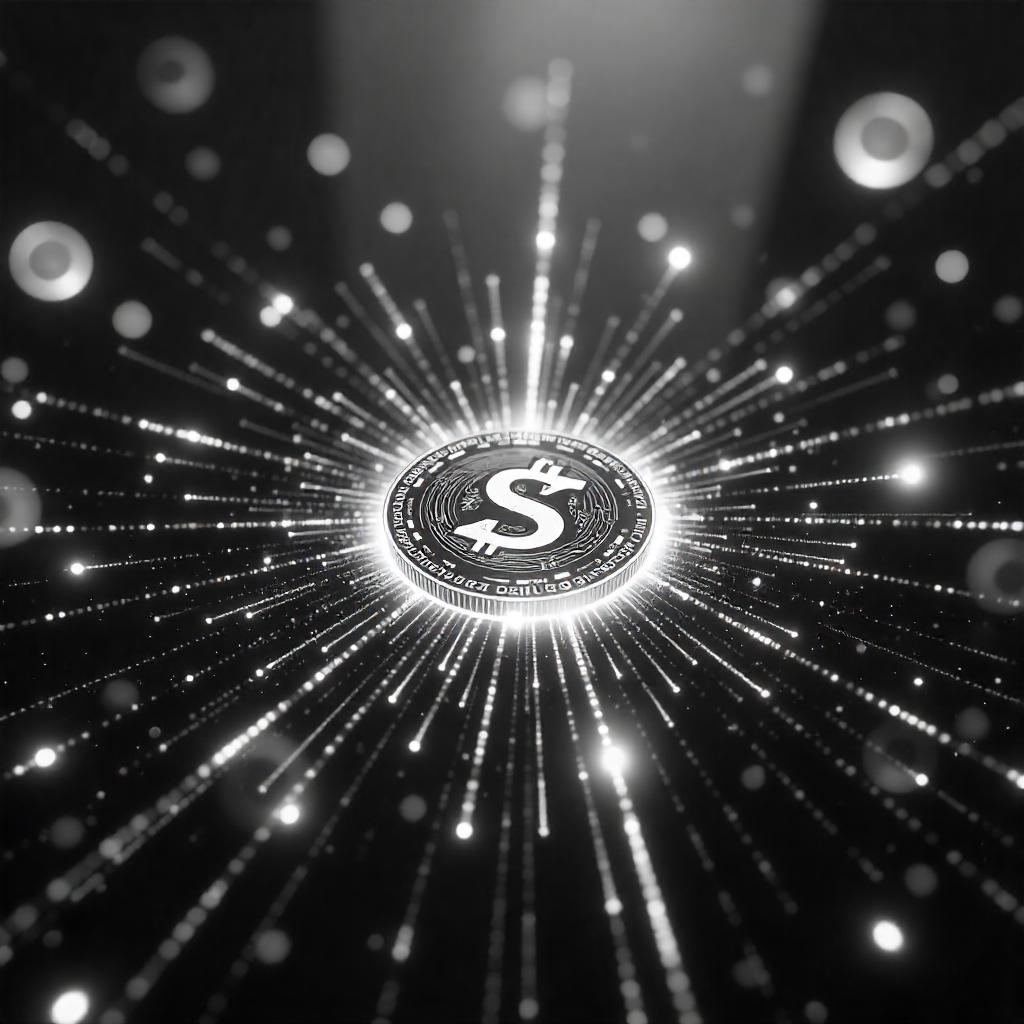In the ever-evolving landscape of cryptocurrency, certain developments stand out not just for their novelty but for their profound impact on the industry’s trajectory. One such development is the remarkable 12% weekly growth in USDC’s on-chain settlement volume. This isn’t just a statistic; it’s a testament to the increasing trust and reliance on stablecoins, particularly USD Coin (USDC), in the realm of digital finance.
As cryptocurrency investors and traders, understanding this growth is crucial. It’s not merely about numbers; it’s about recognizing the underlying trends that could shape trading strategies, influence liquidity, and redefine how we perceive digital transactions. USDC’s rise signifies a shift towards more stable, transparent, and efficient financial ecosystems.
But what does this mean for you? How does this growth translate into tangible benefits or considerations for your trading activities? Let’s delve deeper into the factors driving this surge and explore the implications it holds for the future of cryptocurrency trading.
Section 1: Understanding USDC and On-Chain Settlements
What Is USDC?
USD Coin (USDC) is a fully reserved stablecoin pegged 1:1 to the U.S. dollar. Launched in 2018 by Circle and Coinbase through the Centre Consortium, USDC is designed to provide a stable digital dollar for the crypto ecosystem. Unlike some other stablecoins, USDC is fully backed by cash and short-term U.S. Treasury securities, with reserves held in regulated financial institutions and subject to monthly attestations by independent auditors.
As of June 2025, USDC operates on over 21 blockchain networks, including Ethereum, Solana, Avalanche, and XRP Ledger, making it one of the most widely adopted stablecoins in the market. Its broad compatibility and regulatory transparency have contributed to its rapid growth and increasing use in various financial applications.
What Does On-Chain Settlement Mean?
On-chain settlement refers to the process of recording transactions directly on a blockchain, ensuring transparency, security, and efficiency. In the context of USDC, on-chain settlement involves transferring USDC tokens between parties on supported blockchain networks, eliminating the need for intermediaries and enabling near-instantaneous, low-cost transactions.
This method of settlement is particularly advantageous in the cryptocurrency space, where traditional banking hours and intermediaries can introduce delays and additional costs. By leveraging blockchain technology, USDC facilitates 24/7 global transactions, making it an attractive option for investors and traders seeking efficient and reliable settlement solutions.
The Role of USDC in the Cryptocurrency Ecosystem
USDC plays a pivotal role in the cryptocurrency ecosystem by serving as a stable medium of exchange, store of value, and unit of account. Its stability, backed by fully reserved assets, provides a reliable alternative to more volatile cryptocurrencies like Bitcoin and Ethereum.
Beyond its use in trading, USDC is integral to various decentralized finance (DeFi) applications, including lending, borrowing, and yield farming protocols. Its programmability and compatibility with smart contracts enable developers to build innovative financial products and services on blockchain platforms.
Furthermore, USDC’s regulatory compliance and transparency have garnered the trust of institutional investors, facilitating its adoption in traditional finance sectors. This growing acceptance underscores USDC’s potential to bridge the gap between traditional financial systems and the emerging digital economy.
Section 2: USDC’s Weekly Growth Trajectory
A Surge in On-Chain Settlement Volume
In 2024, USDC’s weekly trading volume experienced a remarkable surge, reaching $23 billion, a significant increase from $9 billion in 2023 and $5 billion in 2022. This 155% growth underscores a transformative shift in the cryptocurrency landscape, highlighting USDC’s expanding role in on-chain settlements.
This surge is not just a statistical anomaly; it reflects a broader trend of increasing adoption and trust in regulated stablecoins. USDC’s compliance with emerging regulatory standards, such as the European Union’s Markets in Crypto-Assets Regulation (MiCA), has positioned it as a preferred choice among institutional and retail investors seeking transparency and stability.
Factors Driving the Growth
Several key factors have contributed to USDC’s impressive growth trajectory:
- Regulatory Clarity: Circle’s proactive approach to regulatory compliance has instilled confidence among users and institutions alike. In 2024, Circle became the first major global stablecoin issuer to comply with MiCA, enhancing its credibility in the European market.
- Exchange Integration: Major cryptocurrency exchanges, including Binance, Bitstamp, Kraken, and OKX, have integrated USDC into their platforms, facilitating seamless trading and settlement. Binance’s re-listing of USDC in March 2023 significantly boosted its market share, with USDC’s presence on centralized exchanges rising from 60% to over 90%.
- Technological Advancements: The development of Circle’s Cross-Chain Transfer Protocol (CCTP) has enabled efficient and secure transfers of USDC across multiple blockchains, enhancing liquidity and accessibility. As of early 2025, CCTP had facilitated over $20 billion in USDC transfers, demonstrating its effectiveness in supporting cross-chain interoperability.
Implications for Cryptocurrency Investors and Traders
The substantial growth in USDC’s weekly trading volume has significant implications for cryptocurrency investors and traders:
- Enhanced Liquidity: The increased adoption of USDC has improved liquidity across various platforms, enabling faster and more efficient transactions.
- Stable Trading Medium: USDC’s growing dominance in crypto trading provides a more stable asset for trading pairs, reducing exposure to the volatility associated with other cryptocurrencies.
- Global Accessibility: With its integration into numerous exchanges and blockchain networks, USDC offers global accessibility, allowing users to engage in cross-border transactions with ease.
As the cryptocurrency market continues to evolve, USDC’s growth trajectory indicates a shift towards more regulated and stable digital assets, presenting new opportunities and considerations for investors and traders.
Section 3: Implications for Cryptocurrency Investors and Traders
Why Investors Should Pay Attention
The 12% weekly growth in USDC’s on-chain settlement volume isn’t just a headline—it’s a signal. A signal that the crypto market is maturing, becoming more efficient, and, perhaps most importantly, more reliable. For you as an investor or trader, this means a shift towards a more stable and transparent trading environment.
Real-World Impact on Trading Strategies
1. Enhanced Liquidity Across Platforms: USDC’s integration into major centralized exchanges (CEXs) like Binance, Kraken, and OKX has significantly improved liquidity. In fact, Binance’s weekly trading volume for USDC reached $24 billion in January 2025, accounting for nearly 50% of the global USDC trading volume. This liquidity ensures that you can execute large trades without significant slippage, a crucial factor for both day traders and institutional investors.
2. Stable Trading Pairs: With USDC’s growing dominance, many trading pairs are now denominated in USDC rather than more volatile assets. For instance, the share of Bitcoin perpetuals denominated in USDC on Binance and Bybit rose to 3.6% from 0.3% in January 2024. This shift allows for more stable and predictable trading conditions, reducing the impact of market volatility on your trades.
3. Regulatory Confidence: Circle’s proactive approach to regulatory compliance, including becoming the first major global stablecoin issuer to comply with the European Union’s Markets in Crypto-Assets Regulation (MiCA), has instilled greater confidence among investors. This regulatory clarity is particularly appealing to institutional investors who require a higher level of assurance regarding the assets they hold.
Strategic Considerations for Traders
- Utilizing USDC for Arbitrage Opportunities: The increased liquidity and stable trading pairs provided by USDC open up arbitrage opportunities across different exchanges. By capitalizing on price discrepancies between platforms, you can potentially earn profits with minimal risk.
- Risk Management with Stable Assets: Incorporating USDC into your portfolio allows for effective risk management. During periods of high volatility, reallocating assets into USDC can preserve capital while maintaining exposure to the crypto market.
- Engaging in DeFi Activities: USDC’s integration into decentralized finance (DeFi) platforms enables participation in lending, borrowing, and yield farming activities. Its stability and wide acceptance make it a preferred asset for these DeFi applications.
Section 4: USDC’s Role in Decentralized Finance (DeFi)
USDC’s Expanding Footprint in DeFi
As of November 2024, USDC commanded a dominant 69% share of stablecoin trading volume within DeFi platforms, underscoring its pivotal role in decentralized finance. This prominence is further evidenced by its substantial presence in Total Value Locked (TVL), contributing significantly to the over $126 billion in TVL observed in DeFi during the same period.
The surge in USDC’s adoption within DeFi is attributed to its stability, transparency, and regulatory compliance, making it a preferred choice for users seeking secure and efficient financial services without intermediaries.
USDC’s Integration Across DeFi Platforms
USDC’s versatility is evident in its integration across various DeFi protocols, facilitating a range of financial activities:
- Lending and Borrowing: Platforms like Aave and Compound enable users to lend USDC and earn interest or use it as collateral for borrowing other assets.
- Yield Farming: Protocols such as Uniswap and Sushiswap offer liquidity pools where users can provide USDC to earn transaction fees and additional rewards.
- Derivatives Trading: Exchanges like Synthetix allow for the creation and trading of synthetic assets, with USDC often used as collateral or a trading pair.
These integrations not only enhance the utility of USDC but also contribute to the liquidity and efficiency of the DeFi ecosystem.
USDC’s Impact on DeFi Metrics
The increasing use of USDC in DeFi has led to notable improvements in key metrics:
- Transaction Volume: USDC’s involvement in DeFi transactions has led to higher trading volumes, reflecting increased user participation and market activity.
- Liquidity Depth: The widespread use of USDC in liquidity pools has deepened market liquidity, reducing slippage and enhancing price stability.
- User Engagement: The stability and reliability of USDC have attracted a broader user base to DeFi platforms, fostering greater engagement and adoption.
These metrics indicate a maturing DeFi ecosystem, with USDC playing a central role in its development.
Section 5: Circle’s Strategic Developments
The Launch of Cross-Chain Transfer Protocol (CCTP)
Circle’s introduction of the Cross-Chain Transfer Protocol (CCTP) marked a significant advancement in the seamless movement of USDC across various blockchain networks. Unlike traditional bridging methods that often rely on locking assets in smart contracts or maintaining liquidity pools, CCTP employs a burn-and-mint mechanism. This approach ensures that USDC is securely transferred from one blockchain to another without the need for intermediary assets, thereby enhancing both security and efficiency.
The protocol operates by burning USDC on the source chain and minting an equivalent amount on the destination chain, maintaining a 1:1 peg and ensuring the total supply remains constant. This method not only simplifies the transfer process but also reduces the risks associated with traditional bridging techniques, such as smart contract vulnerabilities and liquidity pool exploits.
Introduction of CCTP V2: Enhancing Speed and Flexibility
Building upon the foundation laid by the original CCTP, Circle unveiled CCTP V2, an upgraded version designed to address the growing demand for faster and more flexible cross-chain transactions. One of the standout features of CCTP V2 is the “Fast Transfer” capability, which significantly reduces settlement times from the typical 13–19 minutes on Ethereum and Layer 2 networks to mere seconds. This enhancement is particularly beneficial for applications requiring low-latency transactions, such as decentralized finance (DeFi) protocols and real-time trading platforms.
Additionally, CCTP V2 introduces “Hooks,” a feature that allows developers to automate post-transfer actions, such as asset swaps or treasury management, directly on the destination blockchain. This programmability streamlines workflows and enhances the composability of decentralized applications, enabling more complex and efficient financial operations.
As of early 2025, CCTP V2 has been integrated into several blockchain networks, including Ethereum, Avalanche, and Base, with plans for further expansion to other platforms like Solana and Arbitrum later in the year. This broadening of support ensures that USDC can be transferred swiftly and securely across a wide array of blockchain ecosystems, fostering greater interoperability within the decentralized space.
Strategic Partnerships and Ecosystem Integration
To maximize the utility and adoption of CCTP V2, Circle has formed strategic partnerships with various infrastructure providers and decentralized finance platforms. Notable integrations include platforms like CCTP.Money, Interport, and LI.FI, which have incorporated CCTP V2 into their services, allowing users to leverage the enhanced cross-chain transfer capabilities. These collaborations facilitate a more seamless user experience by enabling faster and more efficient USDC transfers across different blockchain networks.
Moreover, the integration of CCTP V2 into platforms such as Arbitrum and Monad Mainnet further exemplifies Circle’s commitment to expanding the reach of USDC and enhancing its role as a stable and efficient medium of exchange in the decentralized ecosystem. These developments not only improve the liquidity and accessibility of USDC but also contribute to the overall growth and maturation of the decentralized finance sector.
Section 6: Future Outlook for USDC On-Chain Settlements
Projected Growth Trajectory
The trajectory of USDC’s on-chain settlement volume indicates a robust and sustained growth pattern. In 2024, USDC’s weekly trading volume surged to $23 billion, up from $9 billion in 2023 and $5 billion in 2022. This 155% increase underscores a growing preference for regulated stablecoins in the cryptocurrency market.
Looking ahead, analysts predict that USDC’s adoption will continue to rise, driven by factors such as regulatory clarity, technological advancements, and increased institutional participation. The implementation of the European Union’s Markets in Crypto-Assets Regulation (MiCA) has provided a framework that enhances trust in regulated stablecoins like USDC.
Technological Innovations Enhancing Cross-Chain Interoperability
Circle’s development of the Cross-Chain Transfer Protocol (CCTP) has been a significant advancement in facilitating seamless transfers of USDC across different blockchain networks. The introduction of CCTP V2 has further improved transaction speeds and flexibility, reducing settlement times from 13–19 minutes to mere seconds. These enhancements are crucial for applications requiring low-latency transactions, such as decentralized finance (DeFi) protocols and real-time trading platforms.
The broadening of CCTP’s support to include platforms like Arbitrum and Monad Mainnet demonstrates Circle’s commitment to expanding USDC’s reach and enhancing its role as a stable and efficient medium of exchange in the decentralized ecosystem.
Expanding Global Adoption and Institutional Integration
USDC’s integration into various financial platforms and services has facilitated its adoption across different regions. For instance, platforms like Chipper Cash in Africa and Lemon in Latin America have leveraged USDC to provide users with efficient and low-cost cross-border payment solutions.
The increasing adoption of USDC by institutional investors further solidifies its position in the global financial ecosystem. Circle’s compliance with regulatory standards and its transparent reserve management practices have instilled confidence among institutional participants, contributing to USDC’s growing prominence in the market.
Potential Challenges and Considerations
Despite its growth, USDC faces challenges that could impact its future trajectory. The emergence of alternative stablecoins and the evolving regulatory landscape may influence USDC’s market share. Additionally, concerns related to centralization and the control exerted by Circle over USDC’s issuance and redemption processes could affect its adoption among certain user groups.
Furthermore, the scalability of blockchain networks and the environmental impact of energy consumption associated with blockchain operations remain areas of scrutiny. Addressing these concerns will be essential for ensuring the sustainable growth of USDC and other digital assets.
Final Note
USDC’s on-chain settlement volume has experienced significant growth, reflecting a broader trend towards the adoption of regulated stablecoins in the cryptocurrency market. Technological advancements, regulatory clarity, and increased institutional participation are expected to drive further growth and integration of USDC in various financial applications. However, addressing challenges related to competition, centralization, and scalability will be crucial for maintaining USDC’s position as a leading stablecoin in the global financial ecosystem.





